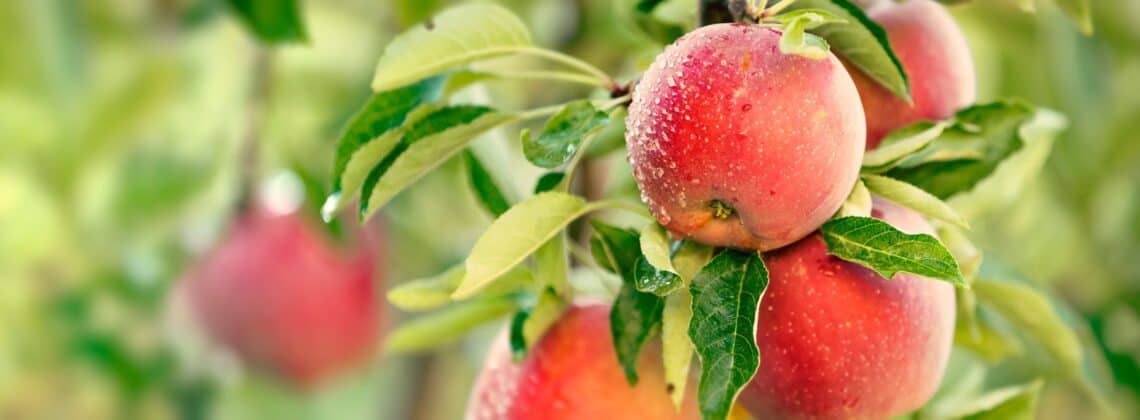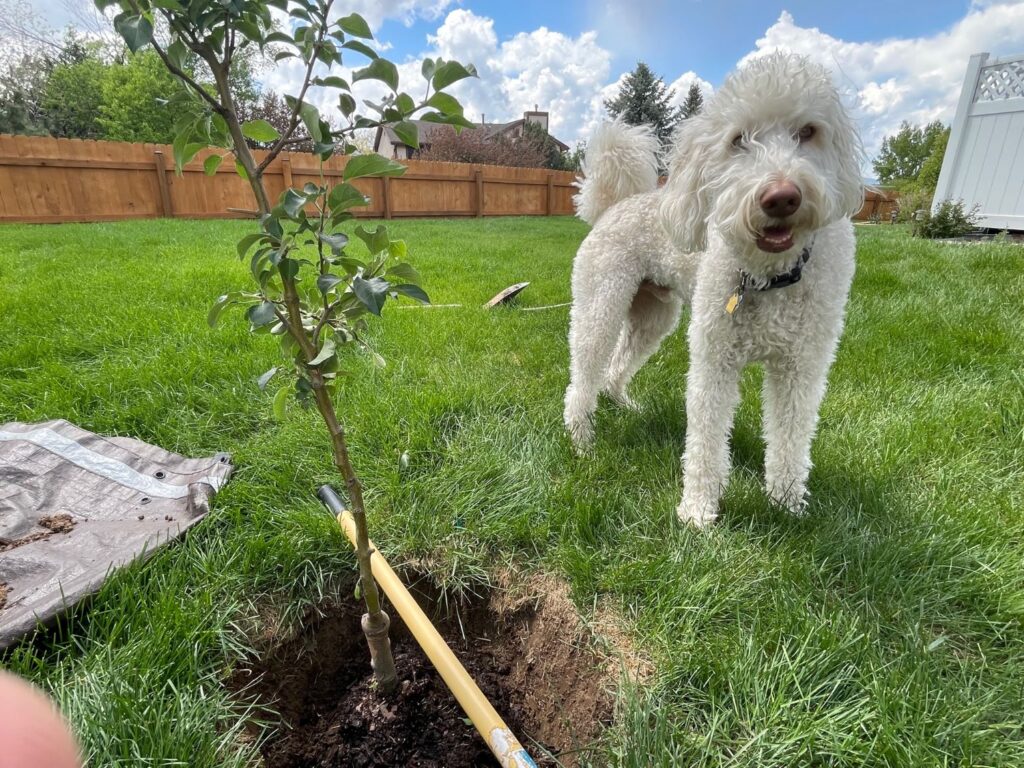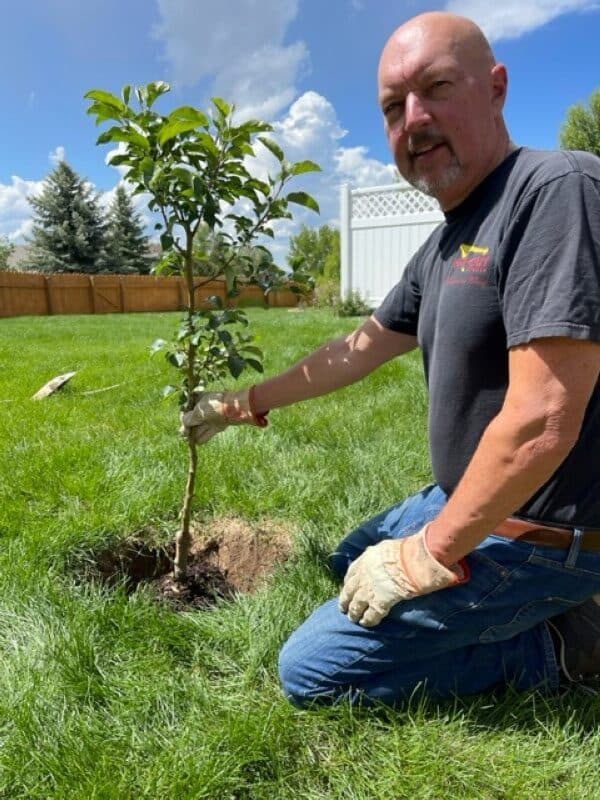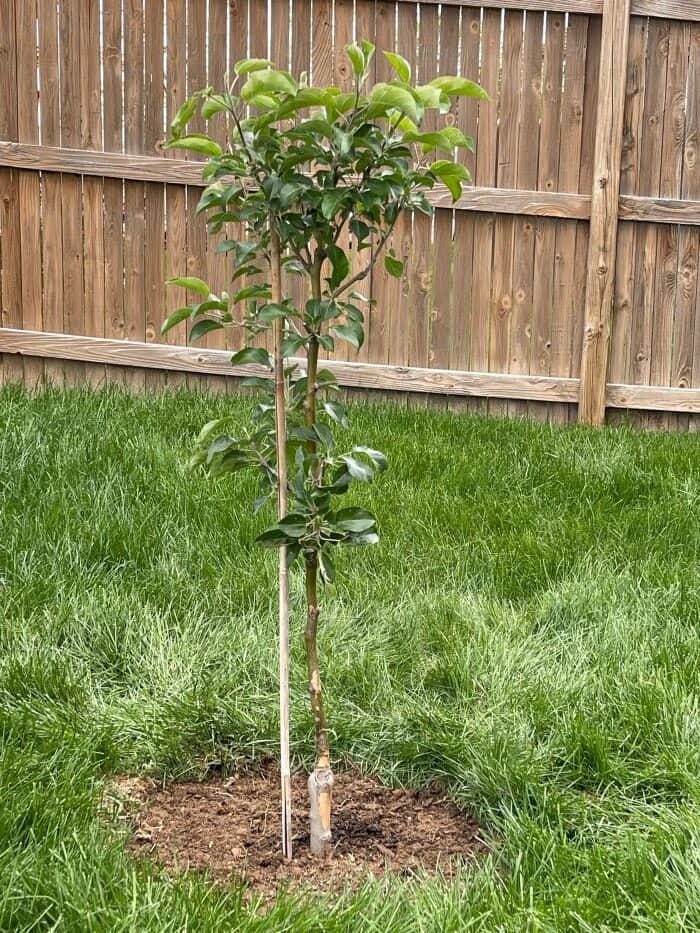
Plant an Apple Tree Using these Step-by-Step Instructions.
Planting an apple tree involves a combination of art and science. It begins with understanding your local conditions and ends with ongoing tree care. In this story, we will provide step-by-step instructions and photos showing the mechanics of how to plant an apple tree. Container-grown trees can be planted in the spring or fall. Bare root trees can be planted in the spring or fall when the trees are dormant.
For more information about selecting the specific variety of apple tree that’s best for you, please read Chose the Right Variety of Apple Tree.

Before You Go to the Tree Nursery
Before you buy an apple tree, make sure there is enough space in your yard to accommodate a mature tree. Standard (full-sized) apple trees can reach 30-40 feet tall and can have a spread (width) of 30-40 feet. A semi-dwarf apple tree can grow to 14-20 feet tall and wide. A dwarf apple tree at maturity will typically reach 6-12 feet tall and wide.
Once you’ve decided on the size of tree you want, there’s one more factor in deciding the location for your tree. Select a location that gets at least six hours of direct sunlight each day. An apple tree needs plenty of sun to produce fruit.
Select the Right Tree
I am going to assume that you will buy your apple tree at a local nursery or big box store. That way, you can select the perfect specimen. Or, you can Order a Tree online at Nature Hills.
While the apple variety is important, the health of the individual tree matters greatly. Look for a tree that has a sturdy, straight trunk without any signs of damage. The tree’s leaves should be a vibrant green, free from spots, yellowing, or wilting.
Next, examine the roots. If the tree is in container (such as a 5-gallon pot), ensure the roots are not circling around the pot excessively. Too many visible roots circling at the bottom of the container indicates the tree is root-bound.
Let’s Plant an Apple Tree!
Now, it’s time to plant. Start digging a hole at the planting site you have selected. If you are digging in a lawn area (like I was for this project), shovel the soil onto a tarp. This will keep your lawn from being damaged.

Dig the hole twice as wide as the root ball and just a bit deeper. This will help to loosen the surrounding soil, making it easier for the roots to spread outward.
Gently remove the tree from the container. If you have purchased a tree in a container larger than 5 gallons, you will probably need an extra pair of hands. Get your neighbor or a family member to help slide the tree out of the container.

Position the tree in the hole. Make sure the graft union (the bulge near the base of the trunk) is 3-4 inches above the soil surface. The bulge is where the tree stock was grafted on the rootstock. It needs to be above the soil, so roots won’t grow from the treestock.
Backfill the hole halfway with soil, then water it thoroughly to eliminate any air pockets. Once the water drains, fill in the rest of the hole. Gently pat the soil down without making it too firm. Water one more time, and you’re done.
Care and Maintenance of an Apple Tree
Now that your tree is planted, it’s time for ongoing care. Regular watering is essential, especially in the first few years. Depending on the climate, it may need watering once a week or more. Deep watering helps encourage the roots to grow deeper, improving the tree’s drought tolerance.

Pruning in the first few years is crucial for establishing a strong structure. Typically, you’ll want to develop a central leader (a single dominant trunk from which other branches sprout).
Prune the tree in late winter before the buds break open to become flowers. Remove any diseased or damaged wood. Trim branches that rub against each other. Also, prune any branches that grow vertically or downwards.
Fertilization is another essential aspect of apple tree care. During the first year, avoid fertilizing until you see new growth. Then, apply a balanced fertilizer (such as 10-10-10) or an organic alternative like compost. Buy Fruit Tree Fertilizer Now.
Monitor the tree’s growth. Too little nutrients can limit growth, but too much can lead to soft, disease-prone growth.
Pest and disease management are also critical. Monitor the tree regularly for signs of pests or diseases like apple scab, fire blight, or codling moth. If you spot any, consult with a local extension service or qualified nursery to identify the best control methods.
Plant an Apple Tree: Final Thoughts
When it comes to growing apples (and other tree fruits), patience is key. It often takes several years for an apple tree to begin producing fruit. But with careful selection, correct planting, and ongoing care, you’ll be rewarded with a bountiful harvest for many years.



Leave a Reply